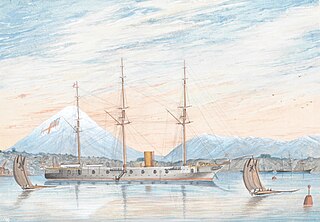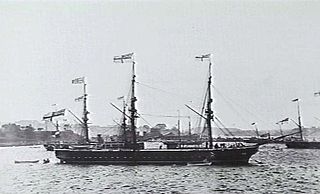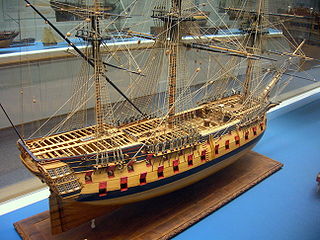
The Danish East India Company refers to two separate Danish-Norwegian chartered companies. The first company operated between 1616 and 1650. The second company existed between 1670 and 1729, however, in 1730 it was re-founded as the Asiatic Company.
HMS Fox was a 32-gun Active-class fifth rate frigate of the Royal Navy. She was launched on 2 June 1780 at Bursledon, Hampshire by George Parsons.

HMS Majestic was a 74-gun third-rate ship of the line launched on 11 December 1785 at Deptford.

HMS Egeria was a 4-gun screw sloop of the Fantome class launched at Pembroke on 1 November 1873. She was named after Egeria, a water nymph of Roman mythology, and was the second ship of the Royal Navy to bear the name. After a busy career in the East Indies, Pacific, Australia and Canada, she was sold for breaking in 1914 and was burnt at Burrard Inlet in British Columbia.

HMS Modeste was a 64-gun third rate ship of the line of the Royal Navy. She was previously the 64-gun Modeste, of the French Navy, launched in 1759 and captured later that year.

Admiral John Gell (1740–1806) was from the Gell and Eyre families of Hopton Hall in Derbyshire. He served with the Royal Navy, fighting in India and taking part in the occupation of Toulon.

HMS Porcupine was a 24-gun Porcupine-class sixth-rate post ship of the Royal Navy built in 1777 and broken up in 1805. During her career she saw service in the American War of Independence and the French Revolutionary Wars.

Admiral Sir George Elliot was a Royal Navy officer who served during the French Revolutionary and Napoleonic Wars, and the First Opium War.

HMS Modeste was a 36-gun fifth rate frigate of the Royal Navy. She had previously been a ship of the French Navy under the name Modeste. Launched in France in 1786, she served during the first actions of the French Revolutionary Wars until being captured while in harbour at Genoa, in circumstances disputed by the French and British, and which created a diplomatic incident. Taken into British service she spent the rest of the French Revolutionary and most of the Napoleonic Wars under the white ensign. She served with distinction in the East Indies, capturing several privateers and enemy vessels, including the French corvette Iéna. She also saw service in a variety of roles, as a troopship, a receiving ship, and a floating battery, until finally being broken up in 1814, as the Napoleonic Wars drew to a close.
Captain The Hon. Robert Boyle-Walsingham was an Irish Royal Navy officer and member of parliament. He was killed in the Great Hurricane of 1780 while serving as a commodore in HMS Thunderer.

HMS Andromache was a 28-gun sixth rate launched in 1832. She was assigned to the North America and West Indies Station, based at the Imperial fortress colony of Bermuda in 1838.
Jean-Marie Dutertre, also called Jean Dutertre, was a French privateer. His ships included Modeste, Heureux, Passe-Partout and Malartic.
HMS Resource was a 28-gun Enterprise-class sixth-rate frigate of the Royal Navy. She was launched in 1778 and sold for breaking up in 1816.

HMS Modeste was a Amethyst-class corvette built for the Royal Navy in the early 1870s.

The Amethyst-class corvettes were a class of the last wooden warships to be built for the British Royal Navy; each was built at a Royal Dockyard. Three were ordered under the 1871-72 Programme and two under the 1872-73 Programme. Built in the early and middle 1870s, they mostly served overseas and were retired early as they were regarded as hopelessly obsolete by the late 1880s.

The Raid on Genoa was a minor naval engagement fought in the harbour of the Italian city of Genoa during the first year of the French Revolutionary Wars. French Republican forces in the Mediterranean, under pressure from Austrian and Spanish armies, Royalist uprisings and British blockade had suffered the loss of their principal naval base and the fleet stationed there when British forces under Lord Hood seized Toulon at the invitation of the city's Royalist faction. The survivors of the French fleet were scattered across the Mediterranean, several sheltering in neutral Italian harbours, including the frigates Modeste at Genoa and Impérieuse at Leghorn.
Vice-Admiral Samuel Reeve was an officer of the British Royal Navy who saw service in the American Revolutionary War and the French Revolutionary Wars.

The action of 17 July 1761 was a naval engagement fought off the Spanish port of Cádiz between a British Royal Navy squadron and a smaller French Navy squadron during the Seven Years' War. British fleets had achieved dominance in European waters over the French following heavy defeats of French fleets in 1759. To maintain this control, British battle squadrons were stationed off French ports, as well as ports in neutral but French-supporting Spain which sheltered French warships. In 1761, two French ships, the 64-gun ship of the line Achille and 32-gun frigate Bouffone were blockaded in the principal Spanish naval base of Cádiz, on the Southern Atlantic coast of Spain.
Blonde was a Coquette-class corvette of the French Navy, launched in 1781. The British Royal Navy captured her in 1793 and sold her in 1794, without apparently ever actually having taken her into service. Mercantile interests purchased her and initially named her Prince, but then renamed her Princess. She became a whaler until a French privateer captured her in 1796 during Princess's first whaling voyage.

HMS Modeste was a modified Black Swan-class sloop of the British Royal Navy. She was built by Chatham Dockyard, during the Second World War, being launched on 29 January 1944 and commissioned on 3 September 1945. Post war, Modeste served with the British Far East Fleet, and took part in the Suez Crisis. She was paid off into reserve for the last time in 1958 and scrapped in 1961.














